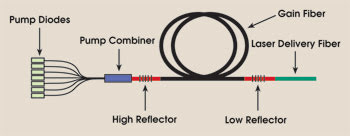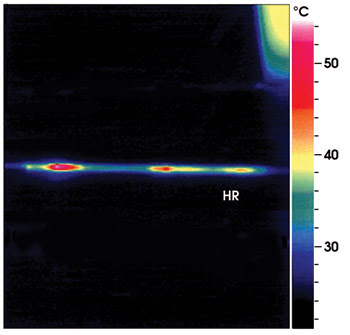Fiber Bragg gratings enable adaptation of fiber optic components for telecommunications as well as for industrial markets.
Daniel Mailloux, François Trepanier, Pierre Bernard and Martin Guy, TeraXion
The telecommunications industry was the first market to use fiber optic components and devices in high volume. The expertise gained by bringing fiber optic components and devices to the performance and reliability levels needed now can be applied in developing applications for other markets. Fiber Bragg grating technology, for example, can be used to develop high-power reflectors for industrial fiber lasers (Figure 1).

Figure 1. This block diagram shows where reflectors typically are used in a fiber laser optical subassembly.
The challenge in using high-power reflectors in fiber lasers is that the reflectors must cope with all the optical power the laser must deliver, well beyond 1 kW for today’s high-end industrial fiber lasers.
The level of technology required to design fiber Bragg grating-based devices for telecommunications is greater than that needed to make fiber laser reflectors. However, some serious challenges exist that are unique to the fiber laser reflector application, such as:
• The design must cope with many propagation modes and with a much higher optical power level (beyond the kilowatt level for the high-end systems).
• The package’s main function (Bragg grating heat sinking) is significantly different from the usual telecommunications objective (keeping the Bragg grating mechanically stable over the temperature range).
• There are new potential failure modes induced by the extremely high level of optical power involved in the fiber laser application.
Qualification test plan
Making sure that a new product meets all the target requirements is a matter of thorough testing. A complete test plan should cover all important aspects, including functional, performance and reliability requirements. Just as it does for telecommunications applications, the functional test plan should ensure that the product provides the main required functions.
The performance test plan for a fiber laser reflector, on the other hand, is less obvious. Test methods used in telecommunications generally are directly reusable, but new test methods must be developed to measure accurately the fundamental mode backreflection and cladding mode coupling, the effective pump loss and the associated local coating temperature rise (Figure 2) and the filtering of higher order modes.

Figure 2. A thermographic scan of a high reflector (HR) grating with 500 W of pump power clearly shows the weak points (hot spots) that may lead to catastrophic failure. Courtesy of Fraunhofer Institute for Laser Technology.
The reliability test plan is the toughest of all to address. In telecommunications, the failure modes of fiber-based components usually are understood well, and standardized tests have been proposed (for example, Telcordia Generic Requirements). When it comes to a new application, such as high-power fiber laser reflectors, these generic requirements are a good base but are insufficient.
New accelerated test methods are needed that are aligned with the potential failure modes inherent in the design. These new test methods should provide strong evidence that the product life will meet the expectations, and/or provide evidence that there is a safe margin between the most demanding operational conditions and the point beyond which the device can be damaged. Failure to apply such a serious reliability test plan most likely will end up with fiber laser system reliability that is very poor, and at the end, customer dissatisfaction.
Volume manufacturing
When the product design is proved to be functional, performing and reliable, the next step is to make sure that the device can be manufactured in volume with a high level of quality and within the target cost. In the fiber laser reflector example, a good starting point is with a mature manufacturing process used to produce telecommunications products. The following steps are recommended to optimize volume manufacturing of fiber laser reflectors:
• Optimize the fiber Bragg grating writing process to write efficiently in every type of fiber in which the reflectors are offered.
• Update the fiber Bragg grating writing process with the new test methods developed to measure properly the fundamental propagation back reflection.
• Develop the stripping and recoating processes to bring pump loss within specifications at a good yield. (This should be done for every possible type of fiber.)
• Design and implement new quality assurance methods throughout the process.
• Implement high-power testing at the end of the overall manufacturing process to ensure that each device can be used safely up to its maximum power limit.
Bringing fiber optic-based components to two different markets using fiber Bragg gratings as the common technology platform has some similarities and some differences. A systematic approach must be followed in both cases, but each application comes with specific requirements.
Meet the author
Daniel Mailloux is senior marketing manager, François Trepanier is senior optical engineer, Pierre Bernard is director of engineering and reliability, and Martin Guy is vice president of technology and product line management at TeraXion in Quebec City; e-mail: [email protected].